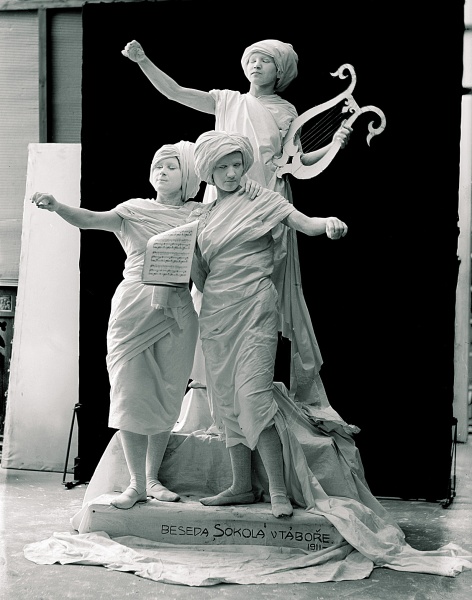|
Dobytí Severního Pólu
''Dobytí severního pólu'' (full title: ''Dobytí severního pólu Čechem Karlem Němcem 5. dubna 1909'', in English: ''The Conquest of the North Pole by the Czech Karel Němec on 5 April 1909'') is a comedy written allegedly by fictional Czech polymath, Jára Cimrman. Its real authors are Zdeněk Svěrák and Ladislav Smoljak. The work was premiered on 25 October 1985 in ''Divadlo Jiřího Wolkera'' in Prague. The play is about a fictional Czech Arctic expedition who conquered the North Pole one day before Robert Peary. As with the other plays supposedly authored by Cimrman, it satirizes Czech national psychology and patriotic clichés, using many puns, historical hoaxes and the distancing effect. It was published as a book, CD, DVD and VHS, and was translated into English by Craig Cravens and by Emilia Machalová and Brian Stewart. The premiere of the Machalová and Stewart version of ''Conquest of The North Pole'' was premiered on April 16, 2016, at the Jára Cimrmana Th ... [...More Info...] [...Related Items...] OR: [Wikipedia] [Google] [Baidu] |
Inuit
Inuit (singular: Inuk) are a group of culturally and historically similar Indigenous peoples traditionally inhabiting the Arctic and Subarctic regions of North America and Russia, including Greenland, Labrador, Quebec, Nunavut, the Northwest Territories, Yukon (traditionally), Alaska, and the Chukotsky District of Chukotka Autonomous Okrug. The Inuit languages are part of the Eskaleut languages, also known as Inuit-Yupik-Unangan, and also as Eskimo–Aleut. Canadian Inuit live throughout most of Northern Canada in the territory of Nunavut, Nunavik in the northern third of Quebec, the Nunatsiavut in Labrador, and in various parts of the Northwest Territories and Yukon (traditionally), particularly around the Arctic Ocean, in the Inuvialuit Settlement Region. These areas are known, by Inuit Tapiriit Kanatami and the Government of Canada, as Inuit Nunangat. In Canada, sections 25 and 35 of the Constitution Act of 1982 classify Inuit as a distinctive group of Abo ... [...More Info...] [...Related Items...] OR: [Wikipedia] [Google] [Baidu] |
Russia
Russia, or the Russian Federation, is a country spanning Eastern Europe and North Asia. It is the list of countries and dependencies by area, largest country in the world, and extends across Time in Russia, eleven time zones, sharing Borders of Russia, land borders with fourteen countries. Russia is the List of European countries by population, most populous country in Europe and the List of countries and dependencies by population, ninth-most populous country in the world. It is a Urbanization by sovereign state, highly urbanised country, with sixteen of its urban areas having more than 1 million inhabitants. Moscow, the List of metropolitan areas in Europe, most populous metropolitan area in Europe, is the capital and List of cities and towns in Russia by population, largest city of Russia, while Saint Petersburg is its second-largest city and Society and culture in Saint Petersburg, cultural centre. Human settlement on the territory of modern Russia dates back to the ... [...More Info...] [...Related Items...] OR: [Wikipedia] [Google] [Baidu] |
Draft Dog
Drafting (also known as carting) is an activity or dog sport in which a dog (usually a large breed) pulls a cart or wagon filled with supplies, such as farm goods, camping equipment, groceries or firewood, but sometimes pulling people. History Drafting involves dogs pulling a cart or wagon, a task historically performed to assist farmers with transporting goods. Ancient History The use of the travois for drafting was practiced in North America, particularly among the Plains Indians. Significant historic routes, such as the Lewis and Clark Trail-Travois Road and Montana's Lewis and Clark Pass, were heavily traversed by travelers using travois. The repeated passage created deep, parallel grooves in the terrain—marks that remain visible today. Additional remnants of travois tracks can be found at the Knife River Indian Villages National Historic Site. Archaeological evidence indicates that travois were utilized prior to the invention of the wheel, with some tracks in New Mexi ... [...More Info...] [...Related Items...] OR: [Wikipedia] [Google] [Baidu] |
Wrestling
Wrestling is a martial art, combat sport, and form of entertainment that involves grappling with an opponent and striving to obtain a position of advantage through different throws or techniques, within a given ruleset. Wrestling involves different grappling-type techniques, such as clinch fighting, throws and takedowns, joint locks, pins, and other grappling holds. Many different wrestling techniques have been incorporated into martial arts, combat sports, and military systems. Wrestling comes in different forms, the most popular being professional wrestling, which is a form of athletic theatre. Other legitimateThe term "wrestling" is most often widely used to specifically refer to predetermined professional wrestling, which is very different from the legitimate (or real-life) wrestling combat predominantly detailed in this article. competitive forms include Greco-Roman, freestyle, judo, sambo, folkstyle, catch, shoot, luta livre, submission, sumo, pehl ... [...More Info...] [...Related Items...] OR: [Wikipedia] [Google] [Baidu] |
Gustav Frištenský
Gustav Frištenský (18 May 1879 – 6 April 1957) was a Czechs, Czech strongman, Greco-Roman wrestling, Greco-Roman wrestler and professional wrestler who competed in the first half of the 20th century. During his career, he won almost 10,000 fights, the first one when he was just 19 years old and the last one when he was 72. He is considered the strongest Czech and a legendary symbol of strength for many Czechs. Biography Frištenský was born as one of six children of Kateřina and Alois Frištenský in the village of Kamhajek, today a part of Křečhoř near Kolín. When he was seven years old he already rode the horses and plowed the fields. At fourteen, his parents sent him to learn to be a blacksmith. During a dispute in the workshop, one of his fellow apprentices passed him an incandescent horseshoe, which caused him serious burns of his hand. After three months of home remedies his father decided to let him learn to be a butcher. After training, he left for Brno, wher ... [...More Info...] [...Related Items...] OR: [Wikipedia] [Google] [Baidu] |
Testicle
A testicle or testis ( testes) is the gonad in all male bilaterians, including humans, and is Homology (biology), homologous to the ovary in females. Its primary functions are the production of sperm and the secretion of Androgen, androgens, primarily testosterone. The release of testosterone is regulated by luteinizing hormone (LH) from the anterior pituitary gland. Sperm production is controlled by follicle-stimulating hormone (FSH) from the anterior pituitary gland and by testosterone produced within the gonads. Structure Appearance Males have two testicles of similar size contained within the scrotum, which is an extension of the abdominal wall. Scrotal asymmetry, in which one testicle extends farther down into the scrotum than the other, is common. This is because of the differences in the vasculature's anatomy. For 85% of men, the right testis hangs lower than the left one. Measurement and volume The volume of the testicle can be estimated by palpating it and compari ... [...More Info...] [...Related Items...] OR: [Wikipedia] [Google] [Baidu] |
Vocative
In grammar, the vocative case (abbreviated ) is a grammatical case which is used for a noun that identifies a person (animal, object, etc.) being addressed or occasionally for the noun modifiers (determiners, adjectives, participles, and numerals) of that noun. A vocative expression is an expression of direct address by which the identity of the party spoken to is set forth expressly within a sentence. For example, in the sentence "I don't know, John," ''John'' is a vocative expression that indicates the party being addressed, as opposed to the sentence "I don't know John", in which "John" is the direct object of the verb "know". Historically, the vocative case was an element of the Indo-European case system and existed in Latin, Sanskrit, and Ancient Greek. In many modern Indo-European languages (English, Spanish, etc.) the vocative case has been absorbed by the nominative, but others still distinguish it, including the Baltic languages, some Celtic languages and most Slavic l ... [...More Info...] [...Related Items...] OR: [Wikipedia] [Google] [Baidu] |
Germans
Germans (, ) are the natives or inhabitants of Germany, or sometimes more broadly any people who are of German descent or native speakers of the German language. The Basic Law for the Federal Republic of Germany, constitution of Germany, implemented in 1949 following the end of World War II, defines a German as a German nationality law, German citizen. During the 19th and much of the 20th century, discussions on German identity were dominated by concepts of a common language, culture, descent, and history.. "German identity developed through a long historical process that led, in the late 19th and early 20th centuries, to the definition of the German nation as both a community of descent (Volksgemeinschaft) and shared culture and experience. Today, the German language is the primary though not exclusive criterion of German identity." Today, the German language is widely seen as the primary, though not exclusive, criterion of German identity. Estimates on the total number of Germ ... [...More Info...] [...Related Items...] OR: [Wikipedia] [Google] [Baidu] |
Czech Sokol Movement
The Sokol movement (, ) is an all-age gymnastics organization founded in Prague in the Czech lands of Austria-Hungary in 1862 by Miroslav Tyrš and Jindřich Fügner. It was based upon the principle of " a strong mind in a sound body". Sokol, through lectures, discussions, and group outings, provided what Tyrš viewed as physical, moral, and intellectual training for the nation. This training extended to men of all ages and classes, and eventually to women. The movement spread across all the regions populated by Slavic cultures, most of them part of either Austria-Hungary or the Russian Empire: present-day Slovakia, the Slovene Lands, Croatia, Serbia, Bulgaria, Poland ( Polish Sokół movement), Ukraine, and Belarus. In many of these nations, the organization also served as an early precursor to the Scouting movements. Though officially an institution "above politics", Sokol played an important part in the development of Czech nationalism and patriotism, which found expressio ... [...More Info...] [...Related Items...] OR: [Wikipedia] [Google] [Baidu] |
Winter Swimming
Winter swimming is the activity of swimming during the winter season, typically in outdoor locations (open water swimming) or in unheated pools or lidos. In colder countries, it may be synonymous with ice swimming, when the water is frozen over. This requires either breaking the ice or entering where a spring prevents the formation of ice. It may also be simulated by a pool of water at , the temperature at which water freezes. In Nordic countries of Europe as well in Eastern Europe (e.g. Ukraine, Russia, and Baltic countries), winter swimming is a traditional cultural element and part of religious celebrations like the Epiphany in Eastern Orthodoxy. Competitions for winter swimming also exist. Many winter swimmers swim with standard swimsuits rather than with wetsuits or other thermal protection. Famous ice and winter swimmers include Lynne Cox and Lewis Gordon Pugh. Also, many locations in North America and Europe hold polar bear plunges, commonly to celebrate New Y ... [...More Info...] [...Related Items...] OR: [Wikipedia] [Google] [Baidu] |
Still Life
A still life (: still lifes) is a work of art depicting mostly wikt:inanimate, inanimate subject matter, typically commonplace objects which are either natural (food, flowers, dead animals, plants, rocks, shells, etc.) or artificiality, human-made (drinking glasses, books, vases, jewelry, coins, pipes, etc.). With origins in the Middle Ages and Ancient Greco-Roman art, still-life painting emerged as a distinct genre and professional specialization in Western painting by the late 16th century, and has remained significant since then. One advantage of the still-life artform is that it allows an artist much freedom to experiment with the arrangement of elements within a composition of a painting. Still life, as a particular genre, began with Netherlandish art, Netherlandish painting of the 16th and 17th centuries, and the English term ''still life'' derives from the Dutch word ''stilleven''. Early still-life paintings, particularly before 1700, often contained religious and allego ... [...More Info...] [...Related Items...] OR: [Wikipedia] [Google] [Baidu] |








